Just like a car, there are various gasoline options for an aircraft’s piston engine to use.
But what are the differences, and how can we tell what we are using?
Let’s look at some of the current and past types of avgas and what the differences between them are.
Key Takeaways
- Avgas is short for aviation gasoline.
- Avgas types are categorized by octane ratings and additives.
- Dyes are used to visually differentiate the types of avgas.
- Lead in some types of avgas prevents engine damage.
- Pilots must ensure the right type of avgas is used.
Types of Avgas
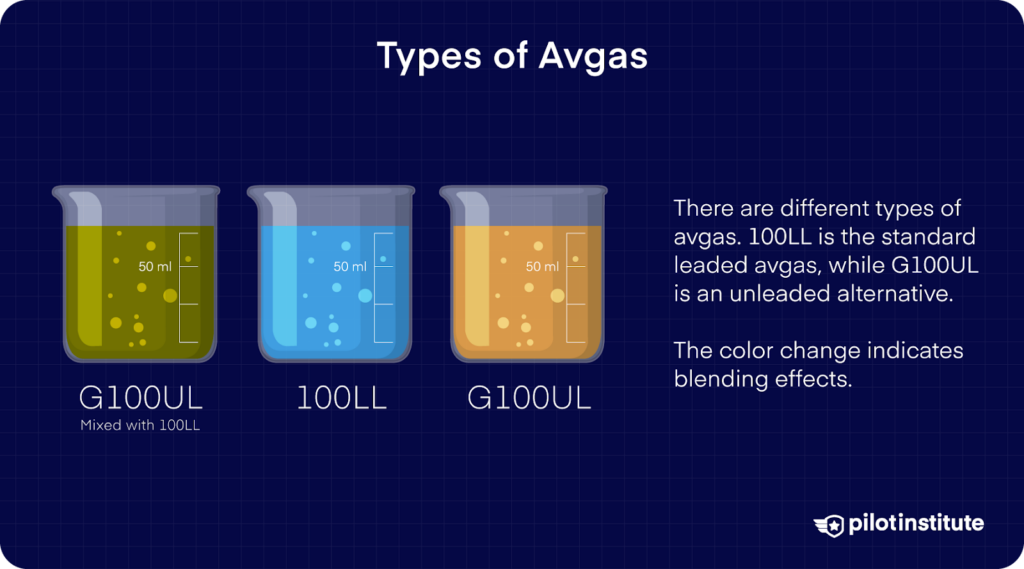
Aviation gasoline, more commonly referred to as avgas, is used in piston engines.
Unlike the gasoline we pump into our cars, avgas has special additives and properties that meet the unique demands of aviation.
The various types of avgas are labeled using numbers and letters. The numbers represent the octane rating, and the letters indicate the additives in the avgas.
Octane rating is the standard measure of a fuel’s ability to withstand compression in the engine without detonating.
The higher the number, the more compression the fuel can withstand before detonating.

Avgas is further differentiated by color using fuel dyes to aid the pilot in quickly recognizing if they are using the right fuel type for their aircraft.
When draining fuel as part of the preflight, the pilot is visually looking for two things – the presence of water in the fuel tanks and the type of fuel.
Both are equally important, as the wrong type of fuel in your fuel tanks can cause damage to your engine in flight.
Leaded Fuel
Some types of avgas contain lead additives, and these types are the only remaining leaded fuels in the United States for transportation.
Tetraethyl lead, commonly referred to as TEL, is the lead-based additive in avgas.
TEL was a common additive for all gasoline engines due to its ability to prevent engine damage.
TEL prevents valve wear damage and, more importantly, is a great antiknock agent.
Antiknock agents allow higher compression ratios in the cylinder for greater efficiency and power.
However, modern health and environmental research has shown the adverse effects of lead, leading to the phaseout and eventual ban of leaded fuel for automobiles.
Avgas is the last transportation fuel in the United States to have lead additives.
100LL
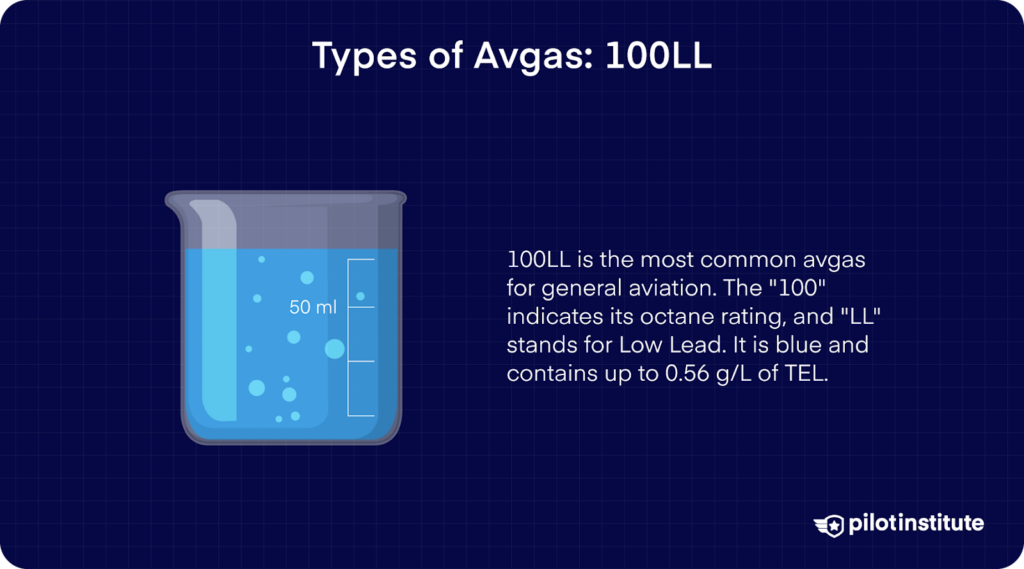
100LL fuel is the most common type of avgas for general aviation.
The “100” represents the octane rating of 100, and the “LL” suffix stands for Low Lead.
100LL fuel is blue in color and contains TEL.
Regulations allow for a maximum lead content in 100LL of 0.56 grams of lead per liter of 100LL.
Unleaded Fuel
With the known hazardous effects of lead, government agencies have been working on replacements for leaded avgas.
These are a few options for unleaded gas currently available to use.
UL91
UL91 is a colorless, lead-free fuel with a 91-octane rating.
UL94
UL94 is produced by Swift Fuels and is clear-colored.
UL94 has an octane rating of 94, and the “UL” prefix stands for unleaded.
This avgas requires the aircraft to be authorized to be able to use UL 94.
G100UL
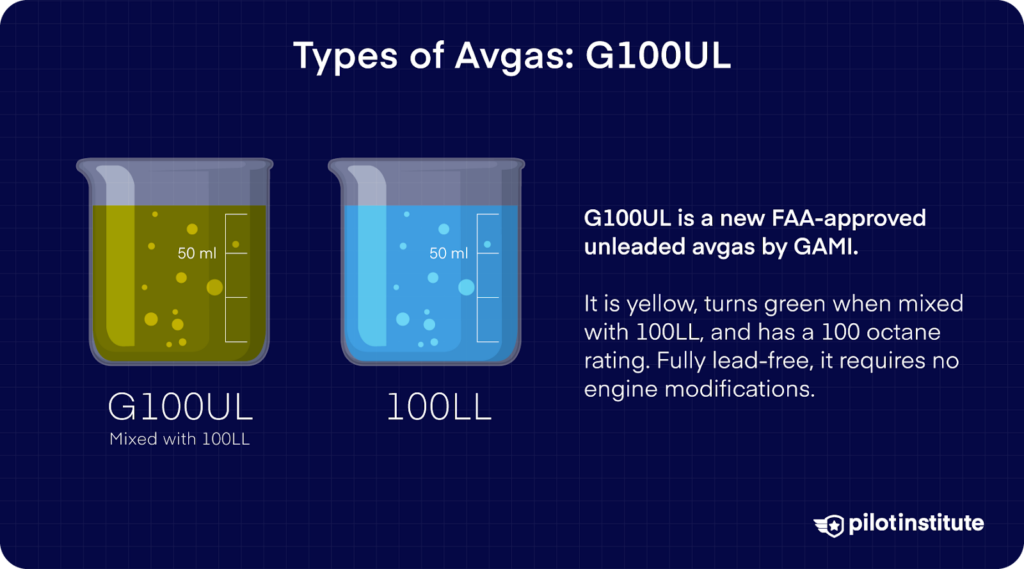
The Federal Aviation Administration (FAA) has most recently approved a new type of unleaded fuel, the G100UL.
G100UL is produced by GAMI and by itself has a yellow color. When blended with the blue 100LL, it has a green tint.
G100UL has an octane rating of 100, and the “UL” suffix stands for unleaded.
This avgas is lead-free and, more importantly, requires no modifications to current engines to accept this fuel.
Avgas Types No Longer in Use
Avgas 80
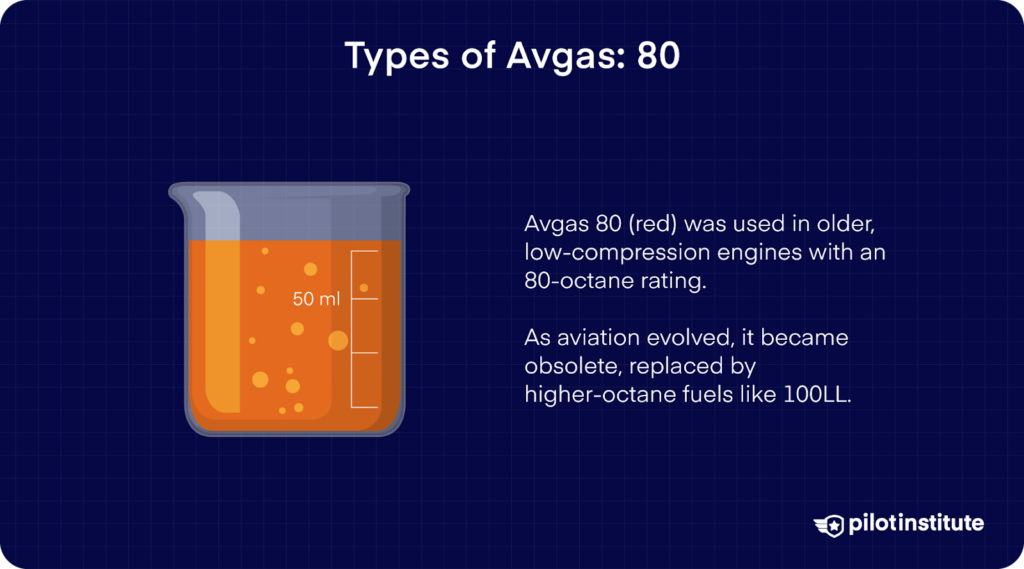
Avgas 80, often identified by its distinct red hue, was a go-to fuel for many light and older aircraft, thanks to its 80-octane rating.
It was designed for engines that didn’t need the punch of high-octane fuels like Avgas 100 or 100LL.
However, with the evolution of aircraft engines and a shift in aviation demands, this red-dyed gasoline has taken a backseat.
Avgas 115
Avgas 115, characterized by its green tint, was a heavyweight in the aviation world due to its high 115 octane rating.
This fuel was perfect for some of the more demanding, high-performance aircraft engines back in the day.
The popularity and need for Avgas 115 diminished over time, with more modern and effective fuel formulations coming into the spotlight.
Avgas 100
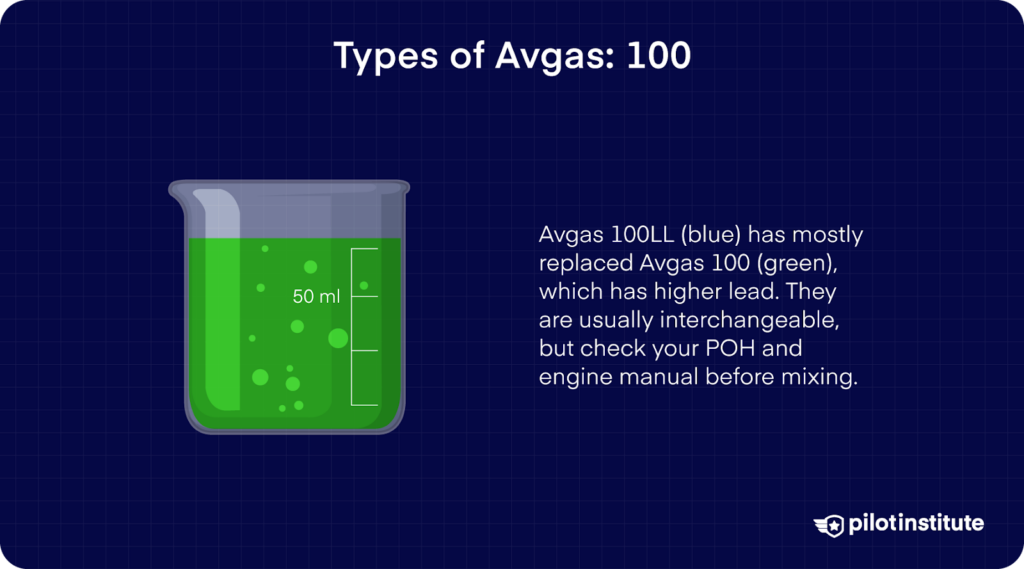
Avgas 100LL has practically replaced Avgas 100, its higher-lead predecessor, but you may still find Avgas 100 at some airports.
Other than the higher lead content, the major distinction is that Avgas 100 is dyed green while Avgas 100LL is dyed blue.
The two are usually interchangeable, but check your POH and engine manual before mixing them together.
Frequently Asked Questions

“What are the different types of aviation fuel?”
There are two main categories of aviation fuel:
- Avgas (Aviation Gasoline), which is used in piston-engine aircraft. Common types include:
- Avgas 100: High-lead fuel for high-performance aircraft.
- Avgas 100LL: Low-lead version of Avgas 100, widely used in general aviation.
- Avgas 80: Low-octane fuel, this is now mostly obsolete.
- Jet Fuel, which is used in turbine-engine aircraft. The main types are:
- Jet A: Common in North America, it’s similar to kerosene.
- Jet A-1: International standard with a lower freezing point.
- Jet B: This fuel type is used in extremely cold climates due to its lower freezing point.
“What is the difference between Avgas 100 and 100LL?”
The difference is the lead content:
- Avgas 100 has a higher level of tetraethyl lead (TEL). This boosts its octane rating and reduces the risk of engine knocks in high-performance aircraft.
- Avgas 100LL (Low Lead) has a lot less lead than Avgas 100 while still keeping the required octane rating for most piston-engine aircraft.
Both fuels are dyed to make them easy to identify:
- Avgas 100 is green.
- Avgas 100LL is blue.
“What is Avgas 80 used for?”
Avgas 80 was a low-octane aviation fuel used in older, low-compression piston engines, typically found in vintage aircraft and light training airplanes. It was dyed red for identification.
Due to limited demand and advancements in engine technology, Avgas 80 has largely been phased out, with most aircraft transitioning to Avgas 100LL as a replacement.
Conclusion
While the most commonly used avgas is the leaded fuel 100LL, the aviation industry is slowly making steps to allow the use of fuels that are better for the environment and health.
The pilot must consult the pilot’s operating handbook in order to determine what fuel types are allowed for the type of engine they have in their aircraft.
If the type of avgas the pilot uses is unavailable at the airport, it is generally safer to use a higher octane fuel, but not lower.
Choosing the wrong one could lead to disastrous consequences in flight, such as engine detonation or engine damage.



